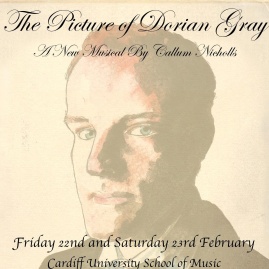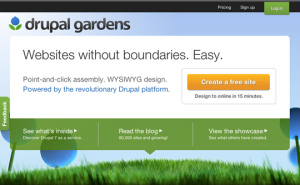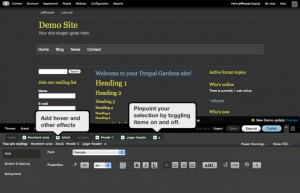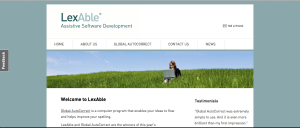This article is intended for smaller arts organisations, but I hope that it will be somewhat useful to arts marketers of all shapes and sizes. A huge thank you to Opera’r Ddraig for agreeing to be featured as an example in this article. You can find more about them (and their upcoming production) on their website.
Can social media be used to sell tickets?

Social is not your personal megaphone – use it wisely, and avoid quick fixes.
Photo by tranchis (via Flickr)
The short answer to this question is: no, not directly. Social media is, for the most part, a passive medium; its users consume far more than they contribute, and they will only respond to others’ posts when they feel that have a genuine reason to do so. With this in mind, how can a tweet or Facebook post convince anyone to part with cold hard cash? One tactic (the ‘hard sell’ approach), is to offer large discounts to people who purchase via social media, greatly reducing the purchase barrier. This tactic is often expensive and does a disservice to the audience members that are paying full price. There is, however, another way. Here’s the long answer:
If you want to sell more tickets to your production, social media can help you do this. Achieving results requires considerable planning and time investment (and time = money, as they say), but I promise it will be worth it. Your use of social media should also be as part of a wider marketing strategy, so think carefully about how it fits in with what you’re doing already. Every arts organisation is different, but here are three tips that should help you to make the most of social media:
1. Content is everything.
The most effective way to engage your audience using social media is to give them what they want: photos, videos, previews, interviews, and anything else that will give them an insight into your production(s) and/or your organisation. An endless stream of tweets is pointless if you’ve nothing to talk about, but genuine content will engage, inform and entertain. Even more importantly, posts that include or link to interesting content are much more likely to be shared or reposted by your followers!
So, with this in mind, make sure you take the time to create meaningful content that you can share with your audience. If you do a flashmob, film it and upload it to YouTube. Take lots of rehearsal photos, plus some quick vox pops with cast and crew – show the world what they’ll be missing! Social media is also a great place to share content from traditional media such as radio interviews, press coverage and past reviews.
2. Exploit your assets and unique selling points.
Social media is a noisy environment. Everyone wants you to read their blog posts or buy their stuff, so you should stand out among the crowd by demonstrating what makes you different to others. For example, here’s the key assets of Opera’r Ddraig, a Cardiff-based opera company:
- Youth – There isn’t an established opera company anywhere else in the UK that is run entirely by young people for the benefit of young people. This is appealing to all sorts of groups, from the young opera sceptics through to seasoned opera lovers looking for something fresh.
- Accessibility – Opera’r Ddraig has always gone out of its way to make established repertoire easy to understand and bang up to date. Their productions are also accessible in the sense that everything is on display: there are no fancy special effects and their instrumentalists and conductor aren’t hidden away in an orchestra pit.
- Credible – with excellent performance quality and proper staging, an Opera’r Ddraig production is just as good as a multimillion-pound staging but in a more intimate setting and at a fraction of the ticket cost!
If you want your social media activity to have more bite, then work out what your unique selling points (USPs) are, then put these on full display. This strategy can be applied to all your marketing activity, by the way.
3. Get your stakeholders involved
If you’re not familiar with this term, a stakeholder is an individual or group that affects, or is affected by, you and your activities. An arts organization’s stakeholders will include:
- cast and crew
- friends and supporters
- existing audience members
- your local community
- other arts organisations
- business partners
These people are already emotionally (or financially) invested in your production, so it should be much easier to get them on your side. Let them know how they can help you to reach a wider audience. If your production has a hashtag (which it definitely should!), make sure everyone knows what it is and tell them to use it when they tweet about the production. Encourage cast and crew to share rehearsal photos and tidbits of information – these will be much more interesting when they come from real people, and will provide you with even more content to share with your audience. Another good tactic is to encourage audience members to post reviews on social media – yet more genuine content and a powerful persuasive tool.
Summary
I hope that you’ve found this post useful, and that it will help you to promote your next production, big or small. Here’s a final summary:
- Focus on content, not the method of delivery.
- Make the most of your USPs.
- Ask your friends and supporters to help get the word out.
Final Thoughts
For arts organisations, social media is so much more than a marketing tool, or a means to sell tickets. The ultimate purpose of the arts is to enrich the lives of others. This goal is far more important than bums on seats or making a profit, and social media is a great way to achieve this. Not all of your followers will be persuaded to come to your production, but if you can inform, educate or entertain them along the way then your time, and theirs, will have been well spent. Keep this in mind when talking about yourself and your production, and you won’t go far wrong. Good luck!
















